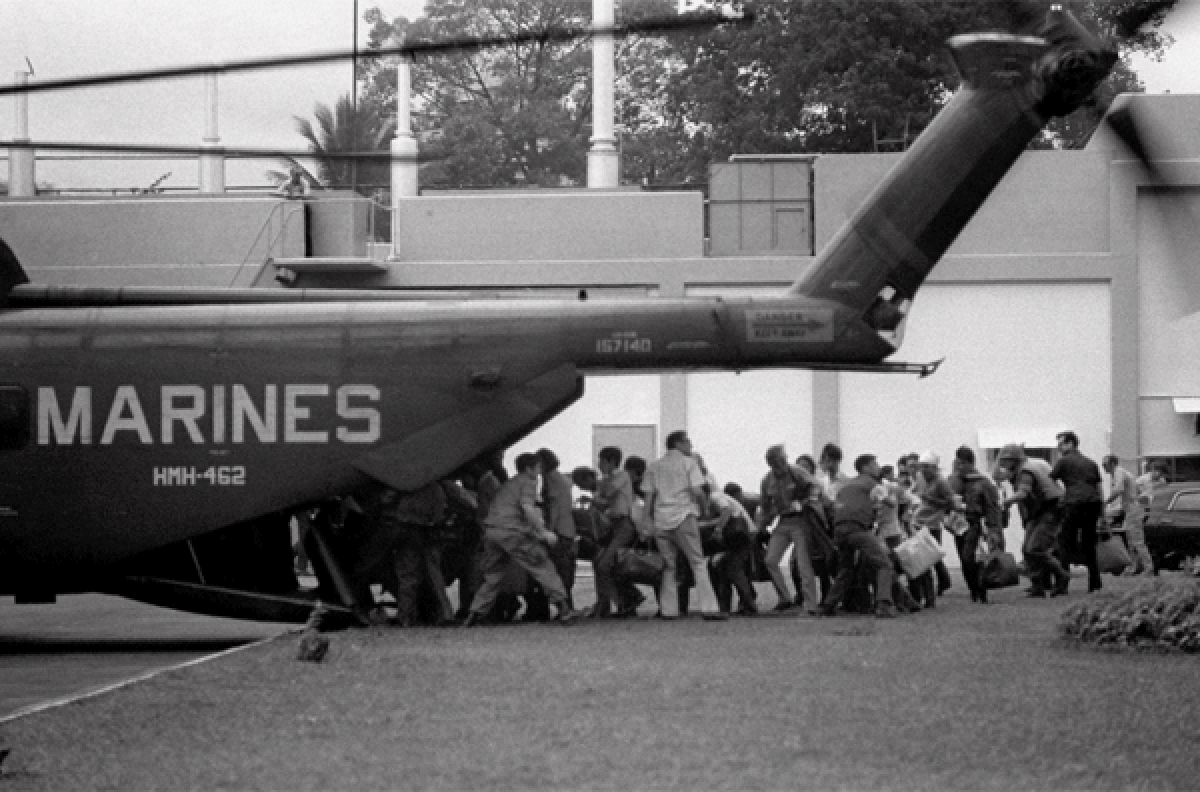The Vietnam syndrome

- Share via
Thirty-eight years ago last week, I was among the last CIA officers to be choppered off the U.S. Embassy roof in Saigon as the North Vietnamese took the country. Just two years before that chaotic rush for the exits, the Nixon administration had withdrawn the last American troops from the war zone and had declared indigenous forces strong enough, and the government reliable enough, to withstand whatever the enemy might throw into the fray after U.S. forces were gone.
That’s the same story we told ourselves in Iraq when we pulled out of that country in 2011. And today, as American troops are being drawn down in Afghanistan, we’re hearing variations on the same claims once again. Yet security remains so fragile in both Iraq and Afghanistan, it is impossible not to worry that we are deluding ourselves and that we failed to learn the most important lessons of Vietnam.
One major ingredient of both the Afghanistan and Iraqi experiments was the use of American dollars to buy off insurgents, wean them from their Al Qaeda or Taliban suitors and win the indulgence, however grudging, of the leadership in Kabul or Baghdad. Such payments may help ensure a lull in the violence to allow U.S. forces to withdraw. But the enduring fallacy of such tactics was made clear in Vietnam.
The strategic hamlet and pacification programs of the early and mid-1960s featured U.S. operatives fanning out through the countryside to buy the quiescence of village and hamlet chiefs. But in the end, the only thing that this money purchased was a continued Balkanization of the political landscape. The local beneficiaries, including special police and paramilitary units, identified with their American bagmen, not with Vietnam’s central government, and the government in turn remained suspicious of their loyalties. The moment U.S. dollars and protection were withdrawn, the central government cracked down, destroying whatever calm existed.
Such an adjustment is now going on in Iraq, where reports are mounting of Shiite vengeance against Sunnis. In Afghanistan, the “stabilizing” effect of U.S. forces and money is belied by a ragged security picture throughout the country and the resurgence of warlords.
In the last year and a half, as the Obama administration has staggered into its Afghan end-game, armed American drones and special commando operations have replaced the expensive counter-
insurgency template designed by Army Gen. David H. Petraeus. But the resulting campaign of targeted killing may not be an improvement because it contains the same ghastly flaws the Phoenix program had in Vietnam. The Phoenix program, a de facto assassination operation run by the CIA and U.S. military and carried out by provincial Vietnamese units, helped put the Viet Cong on the ropes temporarily, by eliminating many of their most experienced fighters and political operatives.
But for all this, the North Vietnamese went on to win. In the end, Phoenix drove people into the arms of the enemy by killing civilians. The cause was often imperfect intelligence from local sources more interested in settling personal scores than in taking out the real enemy. News reports suggest that today’s drone program suffers from similarly tainted targeting, as do periodic security sweeps that continue to deliver Taliban and Al Qaeda suspects to allied detention centers.
Another problem in Vietnam was our choice of bedfellows. By the time I chauffeured the fleeing President Nguyen Van Thieu to Ton Son Nhut air base in late April 1975, some of us in the embassy had come to realize that political or military stability could not coexist with corrupt local leadership. But the last American ambassador to Vietnam had made allowances for Thieu and bent intelligence to cover his faults. In both Iraq and Afghanistan, we have continued to choose our allies unwisely and tolerate their corruption.
Richard Holbrooke, who until his death in 2010 was Obama’s special advisor for Pakistan and Afghanistan, wrestled with another lesson from the Vietnam War, one he learned as a young pacification specialist in the Mekong Delta and a diplomat in Saigon. It was this: A war can’t go well if the enemy is able to move in and out of the country safely thanks to sanctuaries in adjacent countries.
In Vietnam, he’d seen how the Viet Cong slipped into the south easily through Laos and Cambodia, which may have been why Holbrooke labored so diligently to persuade the Pakistanis to break off their enabler’s role in the Afghan insurgency. But the tribal borderlands, along with factions of Pakistani intelligence, remain wellsprings of support for the Taliban and its fellow travelers in Al Qaeda. Even Osama bin Laden was able to find a safe haven in Pakistan for years.
During my own 5 1/2 years in Vietnam, as a CIA analyst, interrogator and operative, I learned another relevant but bitter lesson: Truth does not easily survive the pressures of American troop draw-downs or shifts in policy. The last commanders and intelligence officers on the parapets of a fading U.S. commitment invariably try to put a good face on things, however little cause for optimism there is.
There had been plenty of warning that South Vietnam was going to fall by the time it did on April 29, 1975. But denial and wishful thinking prevented us from adequately preparing for the safety of the many Vietnamese who had cast their lot with us. Their cries of panic over CIA radios on the last day still tear at my conscience.
What haunts me most as the U.S. pullout continues in Afghanistan is the fate of the locals who have trusted our assurances. Let us hope, as the agency’s Saigon station chief wrote in his last message from the embassy, that we have learned enough of history not to repeat it.
Frank Snepp is a Peabody-award winning investigative journalist and the author of two CIA memoirs.
More to Read
A cure for the common opinion
Get thought-provoking perspectives with our weekly newsletter.
You may occasionally receive promotional content from the Los Angeles Times.










